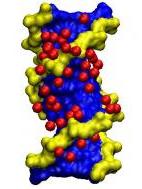A Helmholtz-Zentrum Dresden-Rossendorf (HZDR) research team has found that the texture of the hydration shell surrounding genetic DNA is based on the water content and impacts the form of the genetic substance.
The discovery raises awareness of the biological function of DNA and could help develop DNA-based materials.
The entire surface of the double helix of DNA is surrounded by water molecules, which bind to each other with help from hydrogen bonds. All molecules are not attached the same way.
 HZDR's schematic diagram of a DNA strand with adherent water molecules
HZDR's schematic diagram of a DNA strand with adherent water molecules
According to Dr. Karim Fahmy, head of the Biophysics Division at the Institute of Radiochemistry, some water molecules are bound more firmly than others when the water content is low. All hydrogen bonds become uniformly strong when the water content increases. This alters the shape of the DNA strand: The double helix backbone comprising sugar and phosphate groups bend a little. The DNA shape is based on the actual water content around the molecule.
The DNA was analyzed at the HZDR by doctoral student, Hassan Khesbak. The DNA, derived from salmon testes was developed at first in thin films and moisturized with ultrafine water doses within nano-seconds. Infrared spectroscopy was used to confirm that water bonds varied in strength and that water molecules display varying rest periods at such times. Water bond oscillations in the hydration shell could be stimulated by infrared light. The frequency of the oscillation was found to be indirectly proportional to the hydrogen bond. The sugar particles and base pairs caused strong bonds with the water molecules, but the bonds between the water and the phosphate groups were weaker. The research paper has appeared recently in the Journal of the American Chemical Society.
Karim Fahmy says DNA respond to varying conditions. The double helix form, the hydrogen bond strength, and the DNA volume alter with increased water content. The bound water covering is not a core component of structures that could lead to a precise switching function. Adding two water molecules per phosphate group to the hydrogen sheath could allow the DNA to fold immediately. Such switching processes that depend on water content could control release of active agents from materials based on DNA.